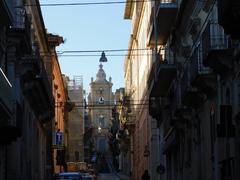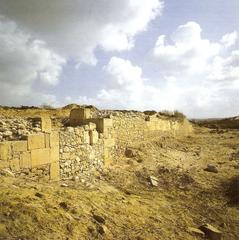Catacombs of Cava Celone: Visiting Hours, Tickets, and Ragusa Historical Sites Guide
Date: 14/06/2025
Introduction
The Catacombs of Cava Celone, nestled amid the scenic Hyblaean Mountains near Ragusa in southeastern Sicily, are among the island’s most significant archaeological sites. Dating from the 4th to 6th centuries CE, this late Roman-Byzantine complex offers an exceptional window into the early Christian communities of Sicily, their burial traditions, and the region’s multicultural history. Carved into soft limestone, these catacombs intertwine religious, social, and architectural heritage, set against a backdrop of rugged canyons and ancient agricultural terraces.
As both a burial ground and a locus for Christian ritual, Cava Celone reflects the transformative shift from pagan to Christian customs and provides invaluable insights into the spiritual and community life of late antiquity. Thanks to recent conservation efforts and cross-border heritage initiatives, the catacombs are accessible to visitors, making them a must-see for history enthusiasts, travelers, and anyone eager to explore Ragusa’s rich past.
For authoritative visitor information and planning, consult sources like La Sicilia in Rete, Ragusa Welcome, and Musei Online.
Table of Contents
- Historical Background
- Architectural and Archaeological Features
- Visitor Information
- Nearby Attractions
- FAQ
- Conclusion
- Sources
Historical Background
Origins and Development
The tradition of underground burial in Sicily predates Christianity, with catacombs reflecting the island’s status as a crossroads of ancient civilizations, including Greek, Roman, and Jewish cultures (Britannica). With the legalization and spread of Christianity in the 4th century, these underground spaces took on communal and spiritual significance, serving both as burial grounds and as venues for religious gatherings. The Catacombs of Cava Celone are among the most important late Roman-Byzantine hypogea in Sicily, alongside sites in Palermo, Syracuse, Marsala, and Agrigento (Vatican.va).
Chronology and Construction
Cava Celone’s necropolis dates from the 4th–6th centuries CE, a time marked by both the decline of Roman paganism and the arrival of Byzantine influence in Sicily (La Sicilia in Rete). The site, spanning roughly 1,500 square meters, features three main hypogea (labeled A, B, and C) and several smaller burial chambers. These were carved directly into the soft limestone of the Hyblaean plateau, exploiting natural canyons and adapting to the local topography (Musei Online).
Religious and Social Context
The catacombs reflect the Christian belief in equality in death, with communal burial spaces and simple tombs characteristic of early Christian humility (Ragusa Welcome). However, more elaborate tombs and rock-carved sarcophagi indicate that social hierarchies persisted. The catacombs were not only burial places but also served for liturgical activities; niches and ceiling recesses once held oil lamps used during rituals, as evidenced by terracotta lamp fragments dated to the 4th–5th centuries CE (Hermes Sicily).
Discovery and Modern Research
Though known locally, Cava Celone was systematically studied only in recent decades. Projects like Archaeotur, funded by cross-border Italian and Maltese collaboration, have enhanced access, installed explanatory signage, and promoted sustainable tourism (La Sicilia in Rete). These initiatives have both safeguarded the delicate environment and broadened public engagement with the site (Fiona Vella).
Architectural and Archaeological Features
Subterranean Structure
The catacombs extend along both sides of a limestone quarry traversed by the Celone stream. Main features include:
- Loculi: Simple rectangular niches carved into walls and floors for individual burials.
- Chamber Tombs: Larger spaces, sometimes for family groups, with multiple burial slots.
- Arcosolia: Arched recesses above burial benches, a hallmark of later Christian burial architecture.
- Sarcophagi: Tombs carved to resemble stone sarcophagi, reserved for individuals of high status (Hermes Sicily).
Hypogeum A is the largest, featuring three parallel galleries extending 10 meters into the rock, with burial niches arranged systematically along the sides.
Decorative Elements and Inscriptions
Decoration at Cava Celone is generally austere, in keeping with early Christian values. Yet, some tombs and sealing slabs bear symbolic motifs:
- Chi-Rho (☧): Christogram symbolizing Jesus.
- Ichthys (Fish): Early Christian symbol.
- Doves, Olive Branches, Palms: Indicating peace, resurrection, and martyrdom.
Inscriptions, where present, are in Latin or Greek, reflecting the region’s cultural blend (Britannica).
Lighting and Ventilation
Vertical shafts (lucernaria) provided light and air, preserving the cool, stable underground environment. Architectural features like lamp niches indicate use during rituals and commemorations.
Visitor Information
Visiting Hours
- General Opening: 9:00 AM to 6:00 PM (year-round)
- Closed: Mondays and major public holidays
- Note: Hours may change seasonally; always verify with local tourism offices or the official Ragusa Welcome site.
Tickets and Guided Tours
- Admission: Free of charge for independent visits. Guided tours, when available, may have a fee—typically bookable through local associations.
- Group and Special Events: Local tour operators and cultural groups such as Esplorambiente may organize guided visits and educational workshops (Esplorambiente).
- Booking: Recommended for guided tours, especially during peak seasons.
Accessibility and Getting There
- Location: About 5–7 km from Ragusa’s city center. GPS coordinates: 36.95233421042 N, 14.697850975877 E.
- Transport: No direct public transport; reach by car, taxi, or as part of a tour.
- Parking: Available near the site.
- Accessibility: Metal walkways and improved paths aid access, but uneven ground and stairs (“scalazza”) make it challenging for visitors with mobility impairments.
Practical Tips
- Footwear: Wear sturdy walking or hiking shoes.
- Clothing: Bring a light jacket (temperatures underground are cool) and sun protection for outdoor areas.
- Supplies: Carry water and snacks; no facilities on-site.
- Safety: Be mindful of livestock and guard dogs in rural areas. Notify someone of your itinerary due to limited mobile coverage.
- Photography: Permitted for personal use without flash; always check current restrictions on-site.
Nearby Attractions
Enhance your visit by exploring:
- Ragusa Ibla: UNESCO-listed Baroque old town.
- Duomo di San Giorgio: Iconic cathedral in Ragusa Ibla.
- Rock Church of Santu Liu: Byzantine-era church near Cava Celone.
- San Leonardo Valley: Scenic hiking trails and natural landscapes.
Combine your visit with these sites for a comprehensive cultural experience (Enjoy Sicilia).
FAQ
Q: What are the Catacombs of Cava Celone’s visiting hours?
A: Generally 9:00 AM to 6:00 PM, closed Mondays and holidays. Verify before your visit.
Q: Is there an entrance fee?
A: No, entry is free. Fees may apply for guided tours.
Q: Are the catacombs accessible for people with disabilities?
A: Improved paths exist, but underground areas remain challenging. Contact site management for details.
Q: How do I get to Cava Celone from Ragusa?
A: By car or taxi (5–7 km); parking is available.
Q: Are guided tours available?
A: Yes, through local tour operators and cultural associations. Booking is recommended.
Q: Can I take photos inside?
A: Non-flash photography is generally allowed; always observe site rules.
Q: Is it family-friendly?
A: Children are welcome under supervision due to uneven terrain.
Conclusion
The Catacombs of Cava Celone are a profound testament to southeastern Sicily’s religious and cultural evolution. Their extensive burial chambers, early Christian iconography, and integration with the Hyblaean landscape make them one of Ragusa’s must-see historical sites. Thanks to ongoing conservation, informative signage, and accessible guided tours, visitors can experience both the spiritual and natural beauty of this unique site.
Combine your exploration of Cava Celone with Ragusa’s Baroque treasures and nearby archaeological gems for an enriching journey through Sicily’s layered past. For updated visiting hours, tour details, and further information, consult resources like Hermes Sicily, Ragusa Welcome, and La Sicilia in Rete.
Stay informed by downloading the Audiala app and following our social media channels for up-to-date travel tips and exclusive content on Ragusa’s historical sites.
Sources
- La Sicilia in Rete
- Ragusa Welcome
- Hermes Sicily
- Musei Online
- Britannica
- Vatican.va
- Enjoy Sicilia
- Esplorambiente
- Le Cave di Ragusa

